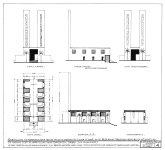Is Ezekiel’s Temple literal or spiritual?
Many look for Ezekiel’s temple built of brick and mortar in Jerusalem in the coming days. One of the points for a spiritual understanding instead is that Ezekiel’s measurements are incomplete. The height measurements do not exist except for the two front pillars. And possibly the first floor is 10 feet. This means people would need to add to God’s word, which is a sin, in order to build it. So if built according to Ezekiel’s given measurements, it would resemble a bar of soap with two chopsticks standing upright, representing the front pillars.
 Gateways of Ezekiel’s Visionary Temple, as described in the Book of Ezekiel, chapters 40-42, drawn as literally as possible by the dutch architect Bartelmeüs Reinders (1893-1979)
Gateways of Ezekiel’s Visionary Temple, as described in the Book of Ezekiel, chapters 40-42, drawn as literally as possible by the dutch architect Bartelmeüs Reinders (1893-1979)
Also with incomplete measurements, only God could build it. And would then represent Jesus, God’s temple made without hands. In whom God lives. So from the beginning, we understand the Temple can only be a symbol of Christ, the Temple made without hands where God lives.
Also, a feature of the Temple runs opposite to the laws of nature. A central characteristic of the Temple makes it more symbolic than literal. The temple vision shows a trickle of water beginning in the temple. And growing in volume as it leaves the temple traveling east, and finally growing into a river.
This also depicts Jesus’s miracles of multiplying the loaves and fishes. He created seeing eyes from clay. And his raising people from the dead, including himself and believers on the last day. Also, Jesus spoke of inexhaustible living waters flowing from the bellies of those who believe in him. All pointing to Christ, the Temple made without hands.
A physical Temple would also reject his shed blood on the cross. And a return to animal sacrifices that would leave sin unatoned for. “For it is not possible that the blood of bulls and of goats should take away sins.” Hebrews 10:4 (KJV 1900) The animal sacrifices called for by Ezekiel found their fulfillment and ended in Christ. And according to Hebrews, they remain eternally fulfilled in him. So this would place all who plan a return to animal sacrifices under the unforgivable sin warnings in Hebrews 6.
Since the kingdom Daniel spoke of had to come in the days of the Roman Empire, which it did. But the physical millennial kingdom they were looking for did not arrive. These blindly thought there must be a restored Roman Empire so their idea of the physical kingdom can be. So today we have a false prophecy about a restored Roman Empire. All based on their inability to see the spiritual kingdom Christ speaks of. Jesus says, unless a person is born-again, they cannot see it in John 3:3.
And since Antichrist must sit in a brick-and-mortar Temple of God, they foresee Ezekiel’s temple as the Third Temple. Since they turned Daniel’s Jesus into Antichrist, he must stop animal sacrifices in the middle of the week. Now placed into the far distant future by inserting a gap of possibly thousands of years between Daniel’s 69th and 70th weeks. Therefore animal sacrifices must resume in the future. But despite these disparate twists of scripture and false prophecies, Daniel shows Christ stopped the sacrifices in the middle of the fulfilled 70th week, with the sacrifice of himself.

